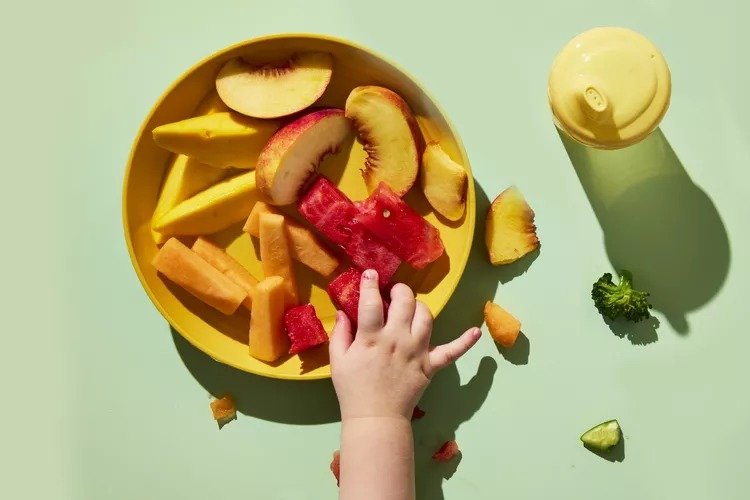10 Ways To Shape Healthy Eating Behaviors for Toddlers

Source: https://www.parents.com/
To shape your toddler’s eating patterns, focus on creating a positive mealtime environment. Offer a variety of healthy foods without pressure, allowing them to explore and taste at their own pace. Involve them in meal preparation to spark interest, and model healthy eating behaviors yourself.
Here are 10 expert tips that may help you shape your toddler’s eating patterns:
1. Set a Good Example: To help prevent eating issues in toddlers, it’s important for adults to model healthy eating habits themselves. According to Jane Kauer, adults who enjoy a variety of nutritious foods in a positive environment are more likely to raise children with healthy attitudes toward food. Demonstrating a balanced relationship with eating not only influences kids’ food choices but also helps them recognize hunger cues and fosters a healthy body awareness, reducing the risk of disordered eating habits.
2. Take the Pressure Off: Experts argue against coercive eating practices, as they can overwhelm children and lead to food aversion, according to dietitian Ellyn Satter. Pressure to eat shifts the focus from nutrition to a child’s desire for autonomy, as noted by former dietitian Betty Ruth Carruth.
3. Avoid Using Food as a Reward: Offering cake as a reward for eating broccoli creates pressure and tension at mealtime, which can backfire by making children dislike broccoli even more, according to Dr. Leann Birch. This practice also sends a misleading message that sweets are more valuable than nutritious foods. Research shows that children who receive food rewards for tasks may value those foods more than those who don’t. To promote a healthy relationship with eating, it’s better to offer fruit instead of sweets, and to treat sweets as occasional treats rather than rewards tied to meals.
4. Don’t Give Up on New Foods Too Soon: Many parents rely on familiar foods like chicken nuggets and grilled cheese, but to encourage a varied diet, a variety of foods must be offered, according to Dr. Jean Skinner. Dr. Leann Birch notes that it can take 10 to 15 exposures for a child to accept a new food, emphasizing the importance of consistent offering without pressure. The American Speech-Language-Hearing Association suggests using the “three Es”—expose, explore, and expand—to help children try new foods. Parents should look for signs of acceptance, such as showing interest in the food, allowing it on their plate, or even just tasting it, and should remain calm regardless of the child’s response.
5. Offer Limited Mealtime Choices: Preparing different meals for each family member can waste time and energy without improving eating habits. Instead, offer limited choices based on what the family is eating, such as letting kids choose between turkey or peanut butter sandwiches. It’s important to include at least one familiar item that the child likes at each meal, as advised by Ellyn Satter. If a child decides not to eat anything, the American Academy of Pediatrics recommends offering the food again later.
6. Keep Serving Sizes Small: In a world of large portions, it’s important to remember that children need smaller, child-sized servings. A helpful guideline is to serve about 1 tablespoon of food for each year of the child’s age. Large portions can be overwhelming for kids and may lead to disappointment for parents. Starting with small amounts, like one green bean, is better than none, and parents can always offer more if the child is willing to eat.
7. Limit Juice and Snacks: Many children snack throughout the day on unhealthy options like cookies and juice, which can fill them up and reduce their appetite for nutritious meals. Dr. Vartabedian suggests that parents shouldn’t eliminate snacks but rather use them as opportunities to provide healthier alternatives. Establishing a routine for snack times with a few healthy options can be beneficial. The American Academy of Pediatrics recommends limiting juice intake to 4 ounces daily for children ages 1 to 3, as it offers little nutritional value and is high in sugar.
8. Allow for Messes: Young children often learn about food through tasting, so it’s important to be patient with messy mealtimes, as this helps them explore different foods. Dr. Vartabedian emphasizes that feeding is a multisensory experience, and toddlers who are allowed to play with food may develop a better enjoyment of it. For toddlers, the focus should be more on what they eat rather than how they eat it, such as using a fork.
9. Keep Typical Development in Mind: Not all children will learn to enjoy every food, and some may be more sensitive to certain flavors, particularly bitterness. During preschool years, many kids experience food neophobia, a natural fear of new foods, which can be mistaken for pickiness. Dr. Birch notes that this is a normal and adaptive response, varying by temperament, and is often more pronounced in children with autism spectrum disorder (ASD). If a child consistently refuses new foods, it may be due to neophobia, and parents should continue to offer those foods without pressure. If concerns about their diet persist, consulting a healthcare provider or a registered dietitian can help identify suitable substitutions.
10. Relax: Even children who seem to eat only macaroni and cheese may not have as poor a diet as parents think, as labeling them as “picky eaters” can create a self-fulfilling prophecy, according to Dr. Vartabedian. Many children improve their eating habits with age, and normal growth patterns indicate they are meeting their nutritional needs. While a multivitamin can provide reassurance, getting nutrients from food is preferable. Keeping a food diary for a week can help parents see if their child is getting at least one serving from each food group.
Read More: https://childreninfobank.com/safebank/10-ways-to-shape-healthy-eating-behaviors-for-toddlers/
Image Source:https://www.parents.com/





